Most people know that China traditionally uses a lunar calendar, which is why Chinese New Year usually lands in February. For years, I had seen various printed versions of traditional Chinese calendars. Usually printed on thin rice paper, each month features a brightly-colored, auspicious figure, and always graced with many examples of that year's token animal - this year is the Year of the Rooster.
To be honest, I never looked closely at the printed figures, since the traditional-peasant style didn't appeal to me. I also had never given any thought as to whether the calendars were printed by machine, or by hand.
As it turns out, I should have been more attentive! Since fresh calendars are brought out just once a year as part of the many festivities, great care is taken in their selection. And because they are so important symbolically, most calendars are printed by hand, featuring brand-new images. When you put that all together, you end up with a true work of art.
We felt lucky to have the chance to visit one of the most famous Chinese calendar factories in the country, and watch how they are made. We visited in April, and even though the next New Year was 10 months away, this team was working at full speed to build up their inventory of hand-printed calendars. Their brand is so popular that they sell out every year!
Before explaining the process, here are some of the images used in the final products so you can see what a "typical" calendar image looks like. These three use very traditional good-luck imaegery. Children are often featured, for obvious reasons. The baby in the middle is riding a fish, the word for which is a homynym for "fortune." He's holding a lotus root in one hand and a lotus flower in the other, both symbols of long life. The two kids on the end are also carrying a lotus blossom.
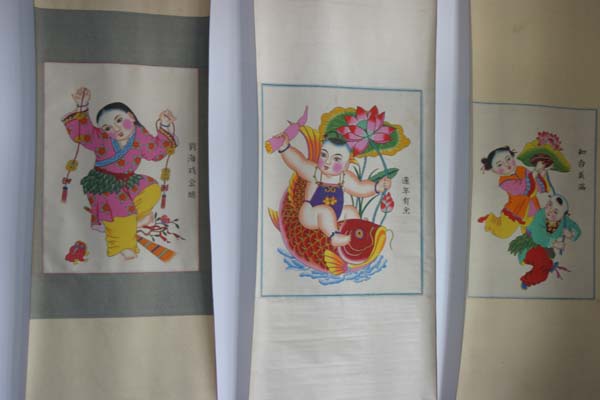
Creating these naive images requires a complex, manual process. Each color is printed, by hand, from a wood block that is also designed and carved by hand.
The first step is to carve the wood blocks, a time-consuming process. Each block has to be carved backwards to produce a positive printed image. In addition, each color requires a different block. The multiple color-blocks must be carved - by hand, remember - exactly the same so that when the colored images are printed they line up perfectly. The block shown here is for the black outlines on the picture. |
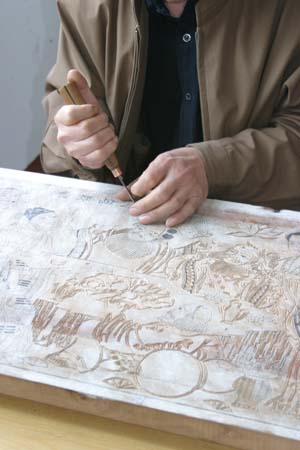 |
| This is a "blue" block, which was used for some of the Chinese characters and details within the picture. |  |
| Not surprisingly, the blocks are themselves works of art. After being used for printing, some are boxed up as a very special gift. | 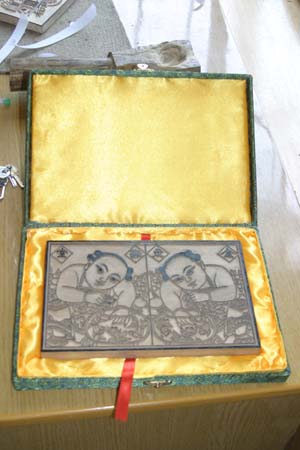 |
| Others just sit in stacks, gathering dust. I asked it I could buy one of these, since they looked unused and unwanted. They looked at me as if I was crazy: "we would NEVER sell these!" -- they are the factory's filing system and heritage in one. | 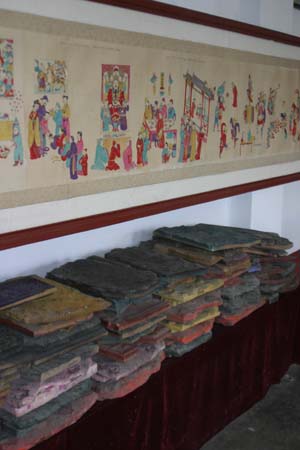 |
the printing process looks very simple, but is anything but. The printer is the workshop's most experienced employee. He has worked here for 50 years.
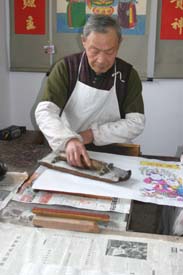 |
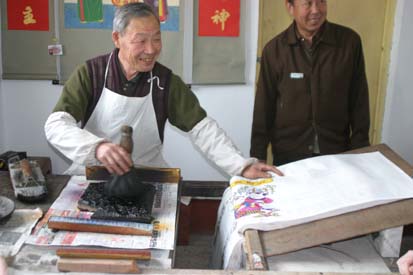 |
He starts with a stack of bound white sheets. He inks a block, flips over one page, quickly smooths it out, flips it back and up, and then does it again. He makes it look SO easy, but remember that the paper is wafer thin, the ink is thick and sticky - and he has thousands of these to do. He didn't use anything but his eye and his memory to line up the images from the different blocks. Decades of experience were his only guide.
|
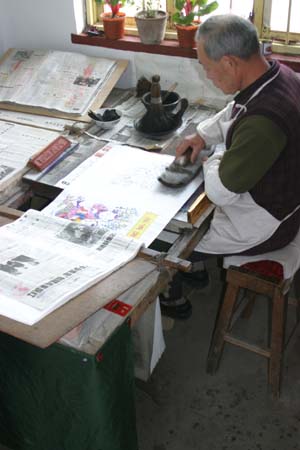 |
| His ink brushes were made out of straw gathered together into something resembling an over-sized shaving-cream brush. Each was assigned its own color pot, which of course never changes over the years. | 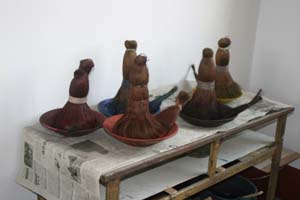 |
| Hanging on the walls around the workshop were copies of their more-famous calendars. This one caught my eye -- the SARS outbreak had a huge impact on China in 2003, but it was suprising to see it memorialized in a 2004 calendar. I wanted to buy one, but they didn't have any extras. Remember, they sell out! | 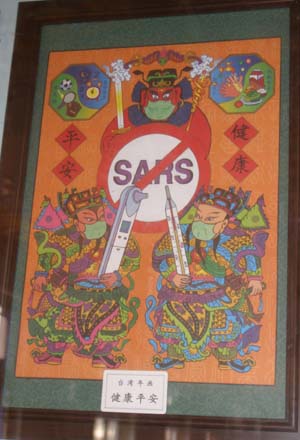 |
But the SARS print was the exception -- the rest of the images were quite traditional, and very beautiful. Here's a close up of one from the top of this page. I know I'll never look at a Chinese New Year's calendar the same way again. Perhaps we'll have especially good luck in this Year of the Rooster, since we spent the day surrounded by so many symbols of good fortune! |
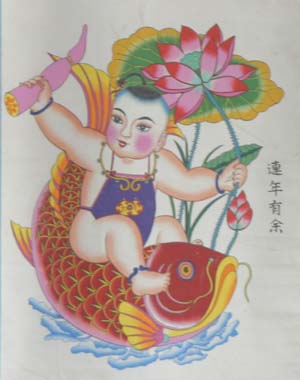 |